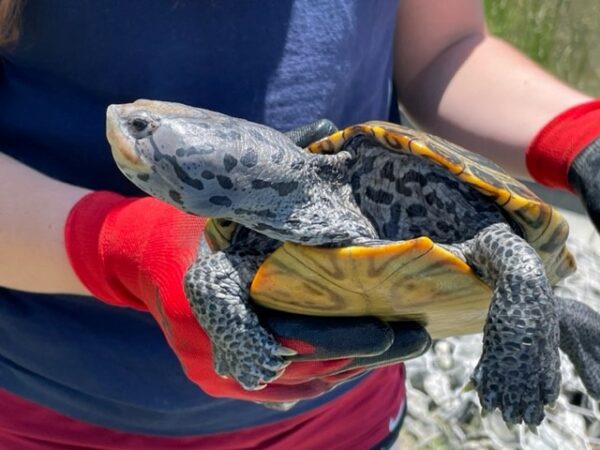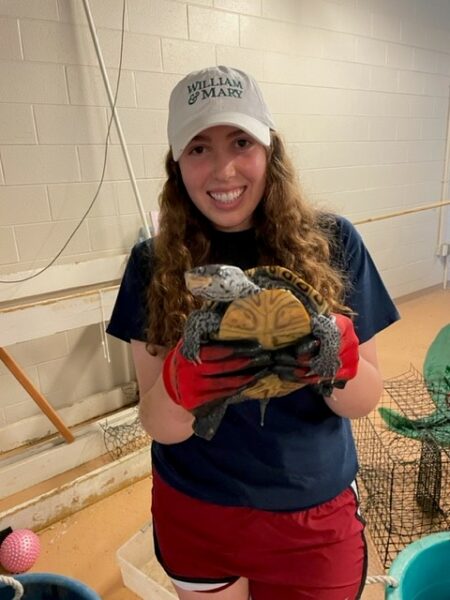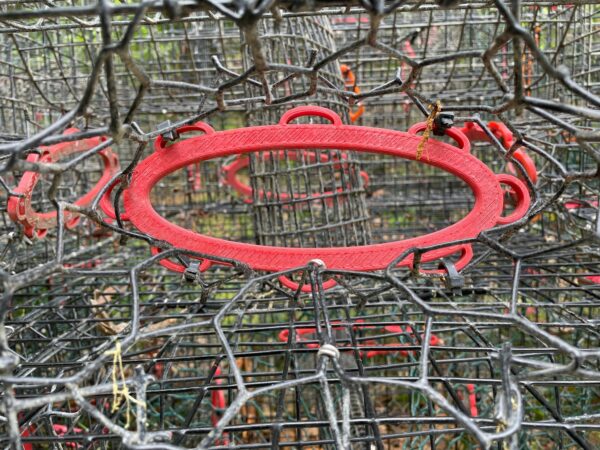W&M Team Hatches an Escape Plan for Diamondback Terrapins
William & Mary ’24 Biology major Lindsey Dillard isn’t afraid of being pinched by blue crabs. Growing up, she spent many of her summers on the water in Virginia’s Northern Neck, where she learned about the crabbing industry from her grandfather, a retired waterman. Her dual interests in crabbing and wildlife conservation drew her to apply to a summer project at W&M’s Keck Environmental Field Lab, investigating a new way to keep diamondback terrapins from drowning in crab traps.
Typically, the only indication of crab traps in the water is a line of buoys bobbing sedately on the surface. The sight feels emblematic of the Chesapeake Bay region’s history, and eating blue crabs is a popular summertime activity for many along the Eastern Seaboard. But the traps set for this “beautiful, savory swimmer” often catch an unintended victim. Diamondback terrapins must surface every forty-five minutes to two hours for air, but for whatever reason they are endlessly curious about crab traps. Terrapins will enter a crab trap whether it is baited or not, sometimes following the lead of other turtles that are already in the trap. Once a turtle enters a crab trap, it generally cannot leave. Though they can theoretically exit the trap via the entrance funnel, terrapins instinctively swim upwards, become caught in the upper chamber of the trap, and eventually drown. You can watch our Keck Lab video on the topic below.
ARVE Error: src mismatchprovider: youtube
url: https://www.youtube.com/watch?v=uf6kPOavS7k&t=1s
src in org: https://www.youtube-nocookie.com/embed/uf6kPOavS7k?start=1&feature=oembed&enablejsapi=1&origin=https://wmblogs.wm.edu
src in mod: https://www.youtube-nocookie.com/embed/uf6kPOavS7k?start=1
src gen org: https://www.youtube-nocookie.com/embed/uf6kPOavS7k
Many research studies have been conducted on the best ways to keep terrapins out of crab traps, and the vast majority have shown that bycatch reduction devices (BRDs, sometimes known as terrapin excluder devices (TEDs)) are highly effective. A Keck Lab study last summer found a 75-100% reduction in terrapin capture in traps with BRDs, compared to control traps. The BRD, invented in the 1990’s, is typically a plastic or wire rectangle installed in the entrance funnels of crab traps.
However, many commercial and recreational watermen are hesitant to use BRDs, citing reductions in crab catch and the cost of BRD installation (though in 2021, we found no significant decrease in legal crab catch in traps set with BRDs, and BRDs cost about 40 cents each). This summer, in addition to conducting a population study of terrapins in a local tidal creek, Lindsey, Dr. Randy Chambers and I worked on developing an escape hatch for turtles that have entered crab traps. Escape hatches are required for many shrimping nets that accidentally capture sea turtles in states such as Florida, and are sometimes used on lobster traps in New England. We hoped to develop an escape hatch that could let terrapins escape, while still maximizing crab catch.
While mulling over escape hatch designs, Lindsey, Dr. Chambers and I got to work on a mark-recapture study of diamondback terrapins in our study creek. A mark-recapture study is a way of approximating terrapin abundance without counting every single turtle in the area. To do this, we notched each turtle shell with a unique number, and then immediately released the terrapins back into the creek. We captured 189 individual terrapins, which is enough terrapins to estimate the likely total population size in the creek.

This was a particularly large terrapin! Terrapins this big are generally female, and even they can get caught in traps.
After getting the population study underway, we were able to return to the question of escape hatches. We tested several escape hatch designs in a brackish water pool at William & Mary’s Virginia Institute of Marine Science (VIMS). There, we learned that terrapins unfortunately like getting into traps more than they like getting out of them! As in previous summers, we found that terrapins will readily swim into traps – this summer, we also found that they tend to ignore or are unable to operate escape hatch openings.
However, we now are back in the field, testing one of our escape hatch designs. So far, results are promising – not yet for terrapins (not enough data), but for crabs, that seem to stay in traps and do not exit via escape hatches. But, we will have to wait until the end of the summer for the final verdict.
Comments are currently closed. Comments are closed on all posts older than one year, and for those in our archive.






thank you for showing us your research! I would love to see these devices in all crab traps in use.